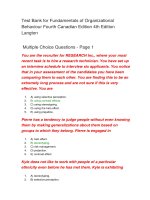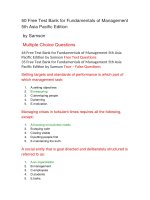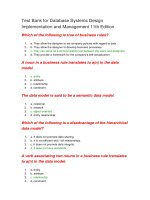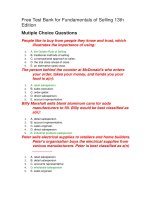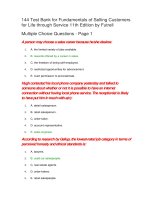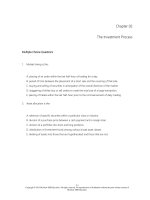Test bank for fundamentals of investments valuation and management 6th edition jordan
Bạn đang xem bản rút gọn của tài liệu. Xem và tải ngay bản đầy đủ của tài liệu tại đây (246.99 KB, 79 trang )
Full file at />
Chapter 01
A Brief History of Risk and Return
Multiple Choice Questions
1. The total dollar return on a share of stock is defined as the:
A. change in the price of the stock over a period of time.
B. dividend income divided by the beginning price per share.
C. capital gain or loss plus any dividend income.
D. change in the stock price divided by the original stock price.
E. annual dividend income received.
2. The dividend yield is defined as the annual dividend expressed as a percentage of the:
A. average stock price.
B. initial stock price.
C. ending stock price.
D. total annual return.
E. capital gain.
3. The capital gains yield is equal to:
A. (Pt - Pt + 1 + Dt + 1)/Pt + 1.
B. (Pt + 1 - Pt + Dt)/Pt.
C. Dt + 1/Pt.
D. (Pt + 1 - Pt)/Pt.
E. (Pt + 1 - Pt)/Pt + 1.
4. When the total return on an investment is expressed on a per-year basis it is called the:
A. capital gains yield.
B. dividend yield.
C. holding period return.
D. effective annual return.
E. initial return.
buy this full document at
Full file at />
5. The risk-free rate is:
A. another term for the dividend yield.
B. defined as the increase in the value of a share of stock over time.
C. the rate of return earned on an investment in a firm that you personally own.
D. defined as the total of the capital gains yield plus the dividend yield.
E. the rate of return on a riskless investment.
6. The rate of return earned on a U.S. Treasury bill is frequently used as a proxy for the:
A. risk premium.
B. deflated rate of return.
C. risk-free rate.
D. expected rate of return.
E. market rate of return.
7. The risk premium is defined as the rate of return on:
A. a risky asset minus the risk-free rate.
B. the overall market.
C. a U.S. Treasury bill.
D. a risky asset minus the inflation rate.
E. a riskless investment.
8. The additional return earned for accepting risk is called the:
A. inflated return.
B. capital gains yield.
C. real return.
D. riskless rate.
E. risk premium.
9. The standard deviation is a measure of:
A. volatility.
B. total return.
C. capital gains.
D. changes in dividend yields.
E. changes in the capital gains rate.
buy this full document at
Full file at />
10. A frequency distribution, which is completely defined by its average (mean) and standard
deviation, is referred to as a(n):
A. normal distribution.
B. variance distribution.
C. expected rate of return.
D. average geometric return.
E. average arithmetic return.
11. The arithmetic average return is the:
A. summation of the returns for a number of years, t, divided by (t - 1).
B. compound total return for a period of years, t, divided by t.
C. average compound return earned per year over a multiyear period.
D. average squared return earned in a single year.
E. return earned in an average year over a multiyear period.
12. The average compound return earned per year over a multiyear period is called the:
A. total return
B. average capital gains yield
C. variance
D. arithmetic average return
E. geometric average return
13. The average compound return earned per year over a multiyear period when inflows and
outflows are considered is called the:
A. total return.
B. average capital gains yield.
C. dollar-weighted average return.
D. arithmetic average return.
E. geometric average return.
buy this full document at
Full file at />
14. Which one of the following statements is correct concerning the dividend yield and the
total return?
A. The dividend yield can be zero while the total return must be a positive value.
B. The total return can be negative but the dividend yield cannot be negative.
C. The total return must be greater than the dividend yield.
D. The total return plus the capital gains yield is equal to the dividend yield.
E. The dividend yield exceeds the total return when a stock increases in value.
15. An annualized return:
A. is less than a holding period return when the holding period is less than one year.
B. is expressed as the summation of the capital gains yield and the dividend yield on an
investment.
C. is expressed as the capital gains yield that would have been realized if an investment had
been held for a twelve-month period.
D. is computed as (1 + holding period percentage return)m, where m is the number of holding
periods in a year.
E. is computed as (1 + holding period percentage return)m, where m is the number of months
in the holding period.
16. Stacey purchased 300 shares of Coulter Industries stock and held it for 4 months before
reselling it. What is the value of "m" when computing the annualized return on this
investment?
A. .25
B. .33
C. .40
D. 3.00
E. 4.00
17. Capital gains are included in the return on an investment:
A. when either the investment is sold or the investment has been owned for at least one year.
B. only if the investment is sold and the capital gain is realized.
C. whenever dividends are paid.
D. whether or not the investment is sold.
E. only if the investment incurs a loss in value or is sold.
buy this full document at
Full file at />
18. When we refer to the rate of return on an investment, we are generally referring to the:
A. capital gains yield.
B. effective annual rate of return.
C. total percentage return.
D. dividend yield.
E. annualized dividend yield.
19. Which one of the following should be used to compare the overall performance of three
different investments?
A. holding period dollar return
B. capital gains yield
C. dividend yield
D. holding period percentage return
E. effective annual return
20. If you multiply the number of shares of outstanding stock for a firm by the price per share,
you are computing the firm's:
A. equity ratio.
B. total book value.
C. market share.
D. market capitalization.
E. time value.
21. Which one of the following is considered the best method of comparing the returns on
various- sized investments?
A. total dollar return
B. real dollar return
C. absolute dollar return
D. percentage return
E. variance return
buy this full document at
Full file at />
22. Which one of the following had the highest average return for the period 1926-2006?
A. large-company stocks
B. U.S. Treasury bills
C. long-term government bonds
D. small-company stocks
E. long-term corporate bonds
23. Which one of the following statements is correct based on the historical returns for the
period 1926-2009?
A. For the period, Treasury bills yielded a higher rate of return than long-term government
bonds.
B. The inflation rate exceeded the rate of return on Treasury bills during some years.
C. Small-company stocks outperformed large-company stocks every year during the period.
D. Bond prices, in general, were more volatile than stock prices.
E. For the period, large-company stocks outperformed small-company stocks.
24. Which category(ies) of investments had an annual rate of return that exceeded 100 percent
for at least one year during the period 1926-2009?
A. only large-company stocks
B. both large-company and small-company stocks
C. only small-company stocks
D. corporate bonds, large-company stocks, and small-company stocks
E. No category earned an annual return in excess of 100 percent for any given year during the
period.
25. For the period 1926-2009, the annual return on large-company stocks:
A. was negative following every three-year period of positive returns.
B. was only negative for two or more consecutive years during the Great Depression.
C. remained negative for at least two consecutive years anytime that it was negative.
D. never exceeded a positive 30 percent nor lost more than 20 percent.
E. was unpredictable based on the prior year's performance.
buy this full document at
Full file at />
26. Which one of the following had the highest risk premium for the period 1926-2009?
A. U.S. Treasury bills
B. long-term government bonds
C. large-company stocks
D. small-company stocks
E. intermediate-term government bonds
27. Based on the period 1926-2006, the risk premium for U.S. Treasury bills was:
A. 0.0 percent.
B. 1.2 percent.
C. 2.0 percent.
D. 2.4 percent.
E. 2.7 percent.
28. Based on the period of 1926-2009, the risk premium for small-company stocks averaged:
A. 12.3 percent.
B. 13.9 percent.
C. 15.0 percent.
D. 16.8 percent.
E. 17.4 percent.
29. The average risk premium on large-company stocks for the period 1926-2009 was:
A. 6.7 percent.
B. 7.9 percent.
C. 8.5 percent.
D. 12.3 percent.
E. 13.6 percent.
30. The average risk premium on long-term corporate bonds for the period 1926-2009 was:
A. 2.4 percent.
B. 2.7 percent.
C. 3.3 percent.
D. 3.7 percent.
E. 3.9 percent.
buy this full document at
Full file at />
31. Which one of the following had the narrowest bell curve for the period 1926-2009?
A. large-company stocks
B. long-term corporate bonds
C. long-term government bonds
D. small-company stocks
E. U. S. Treasury bills
32. Which one of the following had the greatest volatility of returns for the period 19262009?
A. large-company stocks
B. U.S. Treasury bills
C. long-term government bonds
D. small-company stocks
E. long-term corporate bonds
33. Which one of the following had the smallest standard deviation of returns for the period
1926-2009?
A. large-company stocks
B. small-company stocks
C. long-term government bonds
D. intermediate-term government bonds
E. long-term corporate bonds
34. For the period 1926-2009, long-term government bonds had an average return that ______
the average return on long-term corporate bonds while having a standard deviation that
_______ the standard deviation of the long-term corporate bonds.
A. exceeded; was less than
B. exceeded; equaled
C. exceeded; exceeded
D. was less than; exceeded
E. was less than; was less than
buy this full document at
Full file at />
35. The mean plus or minus one standard deviation defines the _____ percent probability
range of a normal distribution.
A. 50
B. 68
C. 82
D. 90
E. 95
36. Assume you own a portfolio that is invested 50 percent in large-company stocks and 50
percent in corporate bonds. If you want to increase the potential annual return on this
portfolio, you could:
A. decrease the investment in stocks and increase the investment in bonds.
B. replace the corporate bonds with intermediate-term government bonds.
C. replace the corporate bonds with Treasury bills.
D. increase the standard deviation of the portfolio.
E. reduce the expected volatility of the portfolio.
37. Which one of the following statements is correct?
A. The standard deviation of the returns on Treasury bills is zero.
B. Large-company stocks are historically riskier than small-company stocks.
C. The variance is a means of measuring the volatility of returns on an investment.
D. A risky asset will always have a higher annual rate of return than a riskless asset.
E. There is an indirect relationship between risk and return.
38. The wider the distribution of an investment's returns over time, the _____ the expected
average rate of return and the ______ the expected volatility of those returns.
A. higher; higher
B. higher; lower
C. lower; higher
D. lower; lower
E. The distribution of returns does not affect the expected average rate of return.
buy this full document at
Full file at />
39. Which one of the following should be used as the mean return when you are defining the
normal distribution of an investment's annual rates of return?
A. arithmetic average return for the period
B. geometric average return for the period
C. total return for the period divided by N - 1
D. arithmetic average return for the period divided by N - 1
E. geometric average return for the period divided by N - 1
40. The geometric mean return on large-company stocks for the 1926-2009 period:
A. is approximately equal to the arithmetic mean return plus one-half of the standard
deviation.
B. exceeds the arithmetic mean return.
C. is approximately equal to the arithmetic mean return minus one-half of the standard
deviation.
D. is approximately equal to the arithmetic mean return plus one-half of the variance.
E. is less than the arithmetic mean return.
41. You have owned a stock for seven years. The geometric average return on this investment
for those seven years is positive even though the annual rates of return have varied
significantly. Given this, you know the arithmetic average return for the period is:
A. positive but less than the geometric average return.
B. less than the geometric return and could be negative, zero, or positive.
C. equal to the geometric average return.
D. either equal to or greater than the geometric average return.
E. greater than the geometric average return.
42. The geometric return on an investment is approximately equal to the arithmetic return:
A. plus half the standard deviation.
B. plus half the variance.
C. minus half the standard deviation.
D. minus half the variance.
E. divided by two.
buy this full document at
Full file at />
43. BLOOM'S formula is used to:
A. predict future rates of return.
B. convert an arithmetic average return into a geometric average return.
C. convert a geometric average return into an arithmetic average return.
D. measure past performance in a consistent manner.
E. compute the historical mean return over a multi-year period of time.
44. One year ago, you purchased 100 shares of Southern Foods common stock for $40.7 a
share.
Today, you sold your shares for $39.70 a share. During this past year, the stock paid $1.40 in
dividends per share. What is your dividend yield on this investment?
A. 3.30 percent
B. 3.37 percent
C. 3.44 percent
D. 3.53 percent
E. 3.61 percent
45. You purchased a stock for $29.40 a share, received a dividend of $0.72 per share, and sold
the stock after one year for $31.30 a share. What was your dividend yield on this investment?
A. 2.30 percent
B. 2.38 percent
C. 2.45 percent
D. 2.67 percent
E. 2.80 percent
46. One year ago, you purchased 300 shares of stock at a cost of $7,521. The stock paid an
annual dividend of $1.10 per share. Today, you sold those shares for $28.20 each. What is the
capital gains yield on this investment?
A. 9.96 percent
B. 10.44 percent
C. 12.49 percent
D. 13.33 percent
E. 14.75 percent
buy this full document at
Full file at />
47. Today, you sold 800 shares of Sky High, Inc., for $57.60 a share. You bought the shares
one year ago at a price of $61.20 a share. Over the year, you received a total of $500 in
dividends. What is your capital gains yield on this investment?
A. -6.03 percent
B. -5.88 percent
C. -4.86 percent
D. 6.25 percent
E. 7.34 percent
48. One year ago, you purchased 400 shares of Southern Cotton at $38.40 a share. During the
past year, you received a total of $480 in dividends. Today, you sold your shares for $41.10 a
share.
What is your total return on this investment?
A. 8.79 percent
B. 9.64 percent
C. 10.16 percent
D. 11.64 percent
E. 12.76 percent
49. You purchased a stock for $46.70 a share and resold it one year later. Your total return for
the year was 11.2 percent and the dividend yield was 2.8 percent. At what price did you resell
the stock?
A. $42.78
B. $50.62
C. $51.93
D. $52.08
E. $57.54
50. A stock sold for $30 at the beginning of the year. The end of year stock price was $30.50.
What is the amount of the annual dividend if the total return for the year was 7.7 percent?
A. $1.11
B. $1.38
C. $1.60
D. $1.81
E. $2.31
buy this full document at
Full file at />
51. Todd purchased 600 shares of stock at a price of $68.20 a share and received a dividend of
$1.42 per share. After six months, he resold the stock for $71.30 a share. What was his total
dollar return?
A. $1,008
B. $1,860
C. $2,712
D. $3,211
E. $3,400
52. Christine owns a stock that dropped in price from $42.40 to $37.20 over the past year. The
dividend yield on that stock is 1.4 percent. What is her total return on this investment for the
year?
A. -11.31 percent
B. -10.86 percent
C. -9.91 percent
D. -9.59 percent
E. -8.51 percent
53. You have been researching a company and have estimated that the firm's stock will sell for
$44 a share one year from now. You also estimate the stock will have a dividend yield of 2.18
percent.
How much are you willing to pay per share today to purchase this stock if you desire a total
return of 15 percent on your investment?
A. $37.55
B. $38.00
C. $38.24
D. $39.00
E. $40.20
buy this full document at
Full file at />
54. Shane purchased a stock this morning at a cost of $11 a share. He expects to receive an
annual dividend of $.27 a share next year. What will the price of the stock have to be one year
from today if Shane is to earn a 15 percent rate of return on this investment?
A. $12.38
B. $12.60
C. $12.88
D. $13.14
E. $14.28
55. Elise just sold a stock and realized a 6.2 percent return for a 4-month holding period.
What was her annualized rate of return?
A. 11.98 percent
B. 14.78 percent
C. 19.78 percent
D. 21.29 percent
E. 27.20 percent
56. You purchased a stock five months ago for $40 a share. Today, you sold that stock for $44
a share.
The stock pays no dividends. What was your annualized rate of return?
A. 23.93 percent
B. 24.77 percent
C. 25.70 percent
D. 26.03 percent
E. 27.67 percent
57. Eight months ago, you purchased 300 shares of a non-dividend paying stock for $27 a
share. Today, you sold those shares for $31.59 a share. What was your annualized rate of
return on this investment?
A. 17.00 percent
B. 21.45 percent
C. 25.50 percent
D. 26.55 percent
E. 28.00 percent
buy this full document at
Full file at />
58. Jason owned a stock for three months and earned an annualized rate of return of 10.02
percent.
What was the holding period return?
A. 2.37 percent
B. 2.42 percent
C. 2.46 percent
D. 2.67 percent
E. 2.72 percent
59. Scott purchased 200 shares of Frozen Foods stock for $48 a share. Four months later, he
received a dividend of $0.22 a share and also sold the shares for $42 each. What was his
annualized rate of return on this investment?
A. -44.69 percent
B. -40.14 percent
C. -33.00 percent
D. -32.90 percent
E. -28.07 percent
60. A stock has an average historical risk premium of 6.4 percent. The expected risk-free rate
for next year is 2.6 percent. What is the expected rate of return on this stock for next year?
A. 6.50 percent
B. 8.86 percent
C. 9.00 percent
D. 9.34 percent
E. 11.70 percent
61. Last year, ABC stock returned 11.4 percent, the risk-free rate was 3.2 percent, and the
inflation rate was 2.8 percent. What was the risk premium on ABC stock?
A. 8.20 percent
B. 8.43 percent
C. 8.60 percent
D. 8.88 percent
E. 8.97 percent
buy this full document at
Full file at />
62. Over the past four years, Sandstone Quarry stock produced returns of 12.6, 15.2, 9.8, and
2.7 percent, respectively. For the same time period, the risk-free rate 4.6, 5.2, 3.8, and 3.4
percent, respectively. What is the arithmetic average risk premium on this stock during these
four years?
A. 5.13 percent
B. 5.25 percent
C. 5.50 percent
D. 5.83 percent
E. 5.97 percent
63. Over the past five years, Teen Clothing stock produced returns of 18.7, 5.8, 7.9, 10.8, and
11.6 percent, respectively. For the same five years, the risk-free rate 5.2, 3.4, 2.8, 3.4, and 3.9
percent, respectively. What is the arithmetic average risk premium on Teen Clothing stock for
this time period?
A. 6.89 percent
B. 7.01 percent
C. 7.22 percent
D. 7.34 percent
E. 7.57 percent
64. Over the past ten years, large-company stocks have returned an average of 11.6 percent
annually, long-term corporate bonds have earned 6.4 percent, and U. S. Treasury bills have
returned 3.2 percent. How much additional risk premium would you have earned if you had
invested in large-company stocks rather than long-term corporate bonds over those ten years?
A. 1.7 percent
B. 3.7 percent
C. 5.2 percent
D. 5.6 percent
E. 8.1 percent
buy this full document at
Full file at />
65. An asset had annual returns of 12, 18, 6, -9, and 5 percent, respectively, for the last five
years.
What is the variance of these returns?
A. .00810
B. .01013
C. .01065
D. .02038
E. .04052
66. Over the past five years, Northern Railway stock had annual returns of 11, 15, -5, 8.5, and
18 percent, respectively. What is the variance of these returns?
A. .00548
B. .00685
C. .00790
D. .01370
E. .02740
67. An asset had returns of 6.8, 5.4, 3.6,-4.2, and -1.3 percent, respectively, over the past five
years.
What is the variance of these returns?
A. .00173
B. .00184
C. .00216
D. .00240
E. .00259
68. An asset had annual returns of 14, 11, -15, 2, and 37 percent, respectively, for the past five
years.
What is the standard deviation of these returns?
A. 8.96 percent
B. 16.05 percent
C. 17.92 percent
D. 18.91 percent
E. 20.03 percent
buy this full document at
Full file at />
69. Over the past four years, a stock produced returns of 13, 6, -5, and 18 percent,
respectively.
What is the standard deviation of these returns?
A. 8.63 percent
B. 9.93 percent
C. 9.97 percent
D. 10.11 percent
E. 10.15 percent
70. Uptown Industries common stock had returns of 9.2, 11.3, 10.6, and 5.4 percent,
respectively, over the past four years. What is the standard deviation of these returns?
A. 2.07 percent
B. 2.38 percent
C. 2.41 percent
D. 2.59 percent
E. 2.63 percent
71. An asset has an average annual historical return of 11.6 percent and a standard deviation
of 17.8 percent. What range of returns would you expect to see 95 percent of the time?
A. -41.8 to +65.0 percent
B. -34.4 to +53.6 percent
C. -24.0 to +47.2 percent
D. -6.2 to +29.4 percent
E. -5.4 to +41.0 percent
72. A stock has an average historical return of 14.3 percent and a standard deviation of 18.2
percent.
Which range of returns would you expect to see approximately two-thirds of the time?
A. -23.8 to +53.0 percent
B. +4.6 to +33.8 percent
C. +5.8 to +31.6 percent
D. -3.9 to +32.5 percent
E. -5.8 to +31.6 percent
buy this full document at
Full file at />
73. An asset has an average historical rate of return of 13.2 percent and a variance of .
00972196. What range of returns would you expect to see approximately two-thirds of the
time?
A. -2.28 to +24.48 percent
B. -6.52 to +32.92 percent
C. -9.58 to +38.8 percent
D. +3.34 to +23.06 percent
E. +13.1 to + 13.3 percent
74. Jeremy owns a stock that has historically returned 8.5 percent annually with a standard
deviation of 11.2 percent. There is only a 0.5 percent chance that the stock will produce a
return greater than _____ percent in any one year.
A. 20.9
B. 22.9
C. 32.2
D. 42.1
E. 54.8
75. Jefferson Mills stock produced returns of 14.8, 22.6, 5.9, and 9.7 percent, respectively,
over the past four years. During those same years, U.S. Treasury bills returned 3.8, 4.6, 4.8,
and 4.0 percent, respectively, for the same time period. What is the variance of the risk
premiums on Jefferson Mills stock for these four years?
A. .00298
B. .00196
C. .00396
D. .00478
E. .00528
buy this full document at
Full file at />
76. Over the past four years, the common stock of JL Steel Co. produced annual returns of
7.2, 4.8, 10.2, and 12.6 percent, respectively. 3.2, 3.4, 4.2, and 4.5 percent, respectively. What
is the standard deviation of the risk premium on JL Steel Co. stock for this time period?
A. 2.23 percent
B. 2.86 percent
C. 3.29 percent
D. 4.46 percent
E. 4.61 percent
77. Big Town Markets common stock returned 13.8, 14.2, 9.7, 5.3, and 12.2 percent,
respectively, over the past five years. What is the arithmetic average return?
A. 10.99 percent
B. 11.04 percent
C. 11.56 percent
D. 12.20 percent
E. 13.80 percent
78. Over the past four years, Hi-Tech Development stock returned 36.1, 42.9, 15.4, and -33.2
percent annually. What is the arithmetic average return?
A. 15.30 percent
B. 17.67 percent
C. 20.53 percent
D. 24.20 percent
E. 32.25 percent
79. You own a stock that has produced an arithmetic average return of 7.8 percent over the
past five years. The annual returns for the first four years were 16, 11, -19, and 3 percent,
respectively.
What was the rate of return on the stock in year five?
A. -5.00 percent
B. 2.75 percent
C. 6.25 percent
D. 28.00 percent
E. 32.00 percent
buy this full document at
Full file at />
80. An asset had annual returns of 19, -38, -17, 25, and 5 percent, respectively, over the past
five years. What is the arithmetic average return?
A. -1.2 percent
B. 0.8 percent
C. 1.2 percent
D. 1.6 percent
E. 2.3 percent
81. Celsius stock had year end prices of $42, $37, $44, and $46 over the past four years,
respectively. What is the arithmetic average rate of return?
A. 3.17 percent
B. 3.85 percent
C. 4.28 percent
D. 10.63 percent
E. 11.79 percent
82. Black Stone Mines stock returned 8, 16, -8, and 12 percent over the past four years,
respectively. What is the geometric average return?
A. 6.59 percent
B. 7.36 percent
C. 7.75 percent
D. 9.94 percent
E. 10.33 percent
83. You invested $5,000 eight years ago. The arithmetic average return on your investment is
10.6 percent and the geometric average return is 10.23 percent. What is the value of your
portfolio today?
A. $9,092
B. $10,623
C. $10,899
D. $10,947
E. $11,195
buy this full document at
Full file at />
84. Jeanette invested $12,000 four years ago. Her arithmetic average return on this investment
is 8.72 percent, and her geometric average return is 8.31 percent. What is Jeanette's portfolio
worth today?
A. $13,989
B. $14,203
C. $16,409
D. $16,514
E. $16,766
85. A stock produced annual returns of 5, -21, 11, 42, and 4 percent over the past five years,
respectively. What is the geometric average return?
A. 5.78 percent
B. 6.03 percent
C. 6.34 percent
D. 7.21 percent
E. 8.20 percent
86. Over the past five years, an investment produced annual returns of 17, 22, -19, 3, and 15
percent, respectively. What is the geometric average return?
A. 5.42 percent
B. 6.49 percent
C. 8.00 percent
D. 15.60 percent
E. 16.00 percent
87. A portfolio had an original value of $7,400 seven years ago. The current value of the
portfolio is $11,898. What is the average geometric return on this portfolio?
A. 7.02 percent
B. 7.47 percent
C. 7.59 percent
D. 7.67 percent
E. 7.88 percent
buy this full document at
Full file at />
88. An initial investment of $25,000 forty years ago is worth $1,533,913 today. What is the
geometric average return on this investment?
A. 9.47 percent
B. 10.84 percent
C. 11.23 percent
D. 11.47 percent
E. 12.08 percent
89. A stock had year end prices of $24, $27, $32, and $26 over the past four years,
respectively. What is the geometric average return?
A. 2.02 percent
B. 2.18 percent
C. 2.55 percent
D. 2.70 percent
E. 2.81 percent
90. The geometric return on a stock over the past 10 years was 8.42 percent. The arithmetic
return over the same period was 9.02 percent. What is the best estimate of the average return
on this stock over the next 5 years?
A. 8.75 percent
B. 9.05 percent
C. 9.08 percent
D. 9.13 percent
E. 9.47 percent
91. The geometric return on an asset over the past 12 years has been 13.47 percent. The
arithmetic return over the same period was 13.86 percent. What is the best estimate of the
average return on this asset over the next 5 years?
A. 13.47 percent
B. 13.67 percent
C. 13.72 percent
D. 13.81 percent
E. 13.86 percent
buy this full document at
Full file at />
92. A stock has an average arithmetic return of 12.55 percent and an average geometric return
of 12.40 percent based on the annual returns for the last 15 years. What is projected average
annual return on this stock for the next 10 years?
A. 12.17 percent
B. 12.21 percent
C. 12.38 percent
D. 12.50 percent
E. 12.69 percent
93. Lisa owns a stock that has an average geometric return of 11.34 percent and an average
arithmetic return of 11.51 percent over the past six years. What average annual rate of return
should Lisa expect to earn over the next four years?
A. 11.38 percent
B. 11.41 percent
C. 11.44 percent
D. 11.47 percent
E. 11.51 percent
94. Tom decides to begin investing some portion of his annual bonus, beginning this year with
$5,000. In the first year he earns a 10% return and adds $3,500 to his investment. In the
second his portfolio loses 5% but, sticking to his plan, he adds $500 to his portfolio. In this
year his portfolio returns 2%. What is Tom's dollar-weighted average return on his
investments?
A. 0.34 percent
B. 1.02 percent
C. 1.54 percent
D. 2.23 percent
E. 2.58 percent
buy this full document at
Full file at />
95. Bill has been adding funds to his investment account each year for the past 3 years. He
started with an initial investment of $1,000. After earning a 10% return the first year, he added
$3,000 to his portfolio. In this year his investments lost 5%. Undeterred, Bill added $2,000 the
next year and earned a 2% return. Last year, discouraged by the recent results, he only added
$500 to his portfolio, but in this final year his investments earned 8%. What was Bill's dollarweighted average return for his investments?
A. 1.5 percent
B. 2.0 percent
C. 2.5 percent
D. 3.0 percent
E. 3.5 percent
96. Jim began his investing program with a $4000 initial investment. The table below recaps
his returns each year as well as the amounts he added to his investment account. What is his
dollar- weighted average return?
A. 0.5 percent
B. 0.8 percent
C. 1.0 percent
D. 1.2 percent
E. 1.5 percent
buy this full document at


